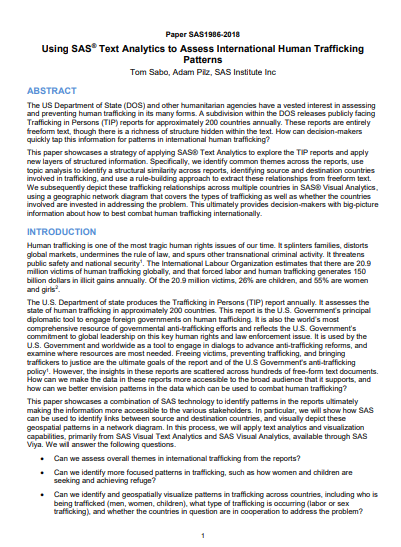Addressing the Retention of Identity Documents
GuidanceGood PracticesThis document calls on businesses to prohibit worker document retention and gives best practice guidance.
By Tom Sabo, Adam Pilz, SAS Institute Inc.
Abstract
The US Department of State (DOS) and other humanitarian agencies have a vested interest in assessing and preventing human trafficking in its many forms. A subdivision within the DOS releases publicly facing Trafficking in Persons (TIP) reports for approximately 200 countries annually. These reports are entirely freeform text, though there is a richness of structure hidden within the text. How can decision-makers quickly tap this information for patterns in international human trafficking?
This paper showcases a strategy of applying SAS® Text Analytics to explore the TIP reports and apply new layers of structured information. Specifically, the authors identify common themes across the reports, use topic analysis to identify a structural similarity across reports, identifying source and destination countries involved in trafficking, and use a rule-building approach to extract these relationships from freeform text. The authors subsequently depict these trafficking relationships across multiple countries in SAS® Visual Analytics, using a geographic network diagram that covers the types of trafficking as well as whether the countries involved are invested in addressing the problem. This ultimately provides decision-makers with big-picture information about how to best combat human trafficking internationally.

This document calls on businesses to prohibit worker document retention and gives best practice guidance.
The 2018 Corporate Human Rights Benchmark assesses 101 of the largest publicly traded companies in the world on a set of human rights indicators. The companies from 3 industries - Agricultural Products, Apparel, and Extractives - were chosen for the ...Read More
The COVID-19 crisis has a potentially far-reaching, long-term negative impact on trafficked and exploited persons. Although at this stage it is not yet possible to assess the full impact of the pandemic on human trafficking, it is sure that its soci...Read More
This booklet is meant as inspiration and provides practical information for managers and employees, who have responsibilities for addressing child labour within the company’s operations and supply chain. The booklet contains business practices an...Read More